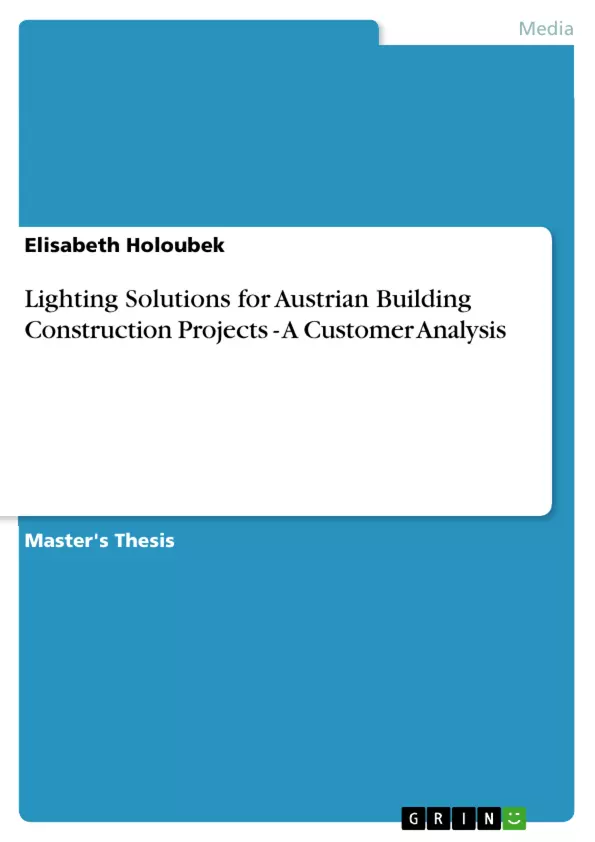The objectives of this Master’s thesis were to develop a better understanding of the Austrian market situation in order to provide lighting solutions in building construction projects.
The theoretical part of this thesis focused on marketing management in general and in special on business-to-business marketing. A large number of theories that have been developed regarding customer targeted marketing, analyzing business markets and business buying behaviour had been discussed.
There were given some ground information to the Austrian market.
Architecture and daylight are inseparably bound together and therefore there was also given some insights to it. In order to understand the great impact of light on people there were given some important ground information and research studies to undercover theories.
The empirical part focused on the qualitative research with a customer analysis. The aim was to gather an in-depth understanding of stakeholder/decision maker behaviour and the reasons that govern such behaviour.
Based on the results there were given some advice for the best payoffs in marketing and sales for the lighting industry in Austria.
At the end of this thesis there were given a future outlook.
Inhaltsverzeichnis (Table of Contents)
- Introduction
- Problem Formulation
- Objective of the Master Thesis
- Theoretical Part
- Marketing Management and Strategy
- Business to Business Marketing (B2B)
- Marketing in New Economy
- Customer Targeted Marketing
- Analyzing Business Markets and Business Buying Behaviour
- Blue Ocean Strategy for B2B Marketing
- Promotional Strategy - a part of Marketing Concept and Marketing Management
- Austrian Market
- Doing Business in Austria
- Business in Austrian Building Construction Industry
- Business Impact of Information Technology (IT)
- Architecture and Light in Building Construction Projects
- General Aspects
- Energy and its Aspects
- Climate Change and Energy Efficiency
- Decisions of the European Union (EuP Directive)
- Incandescent Lamps and Alternative Technologies (like LED)
- Conclusion and Recommendations of German Lighting Society (LiTG)
- Energy Policy in Austria
- Climate Change and Energy Efficiency
- Light and its Impact
- Criteria of a Good Lighting Design
- Our Light Determines our Lives
- Concept Light and Health
- Three Studies about Impact of Light on Health
- Study: Well-being with a Light Impact on Health
- Study: Office Workers Given the Blue Light to Help Alertness
- Study: Light in Geriatric Care
- Qualitative Research
- Approach from Theory to Text
- Research Design and Interviews
- Grounding and Writing
- Empirical Part
- General Information
- Research Approach and Methodology
- Research: A Customer Analysis
- Research Results
- Subject Area: Significance of Lighting
- Subject Area: Situation of the Decision-making
- Subject Area: Information Sources
- Subject Area: Technical Requirements
- Research Subject Area: Future Prospects
- Summary of Key Findings
- General Aspects
- Who are the major stakeholders and decision makers in Austrian building construction projects?
Zielsetzung und Themenschwerpunkte (Objectives and Key Themes)
This master's thesis aims to improve understanding of the Austrian market for lighting solutions in building construction projects. The thesis explores marketing management strategies, specifically focusing on business-to-business (B2B) marketing. It delves into customer-targeted marketing strategies, analyzing business markets and buying behavior. Additionally, the thesis investigates the influence of information technology and energy efficiency on the Austrian construction industry.- Marketing Management and Strategy
- Business-to-Business (B2B) Marketing
- Customer-Targeted Marketing
- Impact of Information Technology and Energy Efficiency
- Lighting Solutions in Building Construction Projects
Zusammenfassung der Kapitel (Chapter Summaries)
The thesis begins with an introduction to the problem formulation and objective of the master's thesis. The theoretical part delves into marketing management, emphasizing B2B marketing strategies and customer-targeted approaches. It explores various frameworks like blue ocean strategy and examines the impact of new economy trends on B2B marketing. The Austrian market section explores the business environment, focusing on the building construction industry and the influence of information technology. The thesis then investigates the interplay between architecture and lighting, discussing energy efficiency, climate change, and the impact of light on people. The European Union's EuP Directive and the German Lighting Society (LiTG) recommendations on incandescent lamp alternatives are also considered. The qualitative research chapter outlines the research design and methodology, including the approach from theory to text and the use of interviews. The empirical part details a customer analysis, investigating the significance of lighting, decision-making processes, information sources, technical requirements, and future prospects in the Austrian building construction industry. Finally, the thesis concludes with a summary of key findings, highlighting the major stakeholders and decision makers involved in Austrian building construction projects.Schlüsselwörter (Keywords)
The main keywords and focus topics of this thesis include marketing management, business-to-business (B2B) marketing, customer analysis, Austrian building construction industry, lighting solutions, energy efficiency, climate change, and information technology. These concepts form the core of the research, exploring the interplay between market dynamics, customer behavior, and technological advancements in the context of the Austrian building construction sector.- Citar trabajo
- Elisabeth Holoubek (Autor), 2011, Lighting Solutions for Austrian Building Construction Projects - A Customer Analysis, Múnich, GRIN Verlag, https://www.grin.com/document/190485



